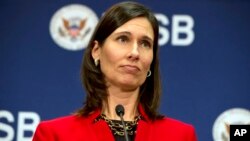Earlier this week, the NTSB -- the National Transportation Safety Board -- determined the cause and subsequent safety regulations from last year’s fatal Asiana crash. The Boeing 777 aircraft crashed on landing at the San Francisco airport, killing three and injuring nearly 200. The former NTSB chairman, who was in charge of the investigation, says the report could change the design of future airplanes.
The National Transportation Safety Board report says the flight crew mismanaged the Asiana plane’s descent and did not monitor airspeed, causing the 777 to crash. Deborah Hersman was the head of the NTSB at the time of the crash and was the voice of the agency, briefing the public on the investigation.
She is now President and CEO of the National Safety Council. Hersman said she knew from her first week at the scene of the crash that the pilots did not understand what was going on with the aircraft's automated systems and did not know how to intervene to regain control of the plane.
“This crew was extremely experienced. They had a lot of hours, but they just didn’t have the ability to understand what was happening in the critical few seconds before the crash," said Hersman. "It wasn’t just one person in the cockpit that didn’t understand. There were three experienced people in the cockpit that didn’t understand what was going on.”
Hersman said the pilots’ confusion could be traced to airplane manuals and simulator training. She said her investigators found instructors who also were unclear about how the 777’s auto throttles perform in different modes. The Asiana pilots disabled the auto throttles, but expected them to maintain speed. They didn't and the plane crashed.
Hersman said the industry needs to make sure pilots understand the automated systems as well as the engineers who designed them, and that could mean a change in how airplanes are built.
“It starts with a good design to make sure you keep the human being in the loop, that the design is human-centered," she said. "And then, it goes through to the process of what is the manufacturer communicating to the operator, what is the operator communicating to its pilots.”
The 777 was introduced to commercial aviation nearly 20 years ago -- the Asiana accident is its first fatal crash. Boeing manufactures the 777 and writes the flight manual, with the airline's input. Boeing disagrees with the NTSB finding that its automation systems contributed to the crash. It says it worked with pilots, unions, and safety agencies to design the systems and says any changes to the design will be reviewed with care.
The pilots who spoke with VOA are split. Some say they, too, find the auto throttle modes complex. Others side with Boeing and say it is up to the individual pilot to study the manuals and to totally understand the airplane and its systems before ever carrying hundreds of people on board.









